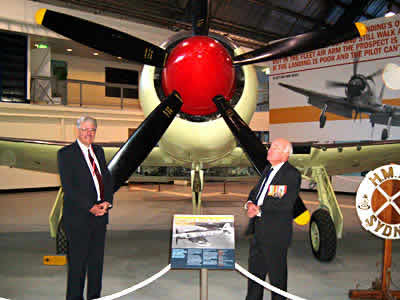FAA Museum, Nowra

The RAN has assumed responsibility for the aircraft museum at Nowra and renamed it the Fleet Air Arm Museum (FAAM). CMDR Shane Moore, Director, Naval Heritage Collection, announced the transfer, to date from 1 September 2006, and the museum became “an element of the Naval Heritage Collection, a Navy Systems Command unit.” Terry Hetherington is the Senior Curator and Manager and it is planned that he should have three staff plus volunteers to support him. In 2007, the RAN Historical Flight was transferred to Navy Systems Command as an NHC element and is closely aligned with the FAAM, although the Flight will be kept as a subunit.
The old Australian Naval Aviation Museum’s name was changed to Australia’s Museum of Flight to reflect a wider community interest in aviation generally, to include civilian aircraft in the display and to encourage more people to visit. The latter did not happen. It will be interesting to see if the Fleet Air Arm Museum name change and other measures achieve the desired result of more bodies through the turnstiles.
Largest regional museum
The Fleet Air Am Museum at Nowra is both the largest regional museum and the biggest pure aviation museum in Australia. The RAAF Museum at Point Cook, the Australian War Museum in Canberra and Fighterworld at Williamtown all have very interesting exhibits, but Australia’s Fleet Air Arm Museum takes pride in having the biggest (and many say the best) display under the one roof open to the public. It certainly has the biggest and best display of naval aircraft in Australia. The aircraft range from a rare early 20th CAG Fairey Firefly Mk IV to the last of the RAN’s fighters, the A-4 Skyhawk. It also has a sleek well-stocked gift shop and integrated lecture theatre. However, the Fleet Air Arm Museum should never be regarded as being in competition with other museums. On the contrary, all of Australia’s leading aviation museums take pride in setting and maintaining a world-recognised standard for preservation of our aviation heritage, as they attract and educate our community.

Museum Foundation Chairman RADM Neil Ralph praised Naval Officers Club members RADM Andrew Robertson and CDRE John Goble for their dedication and efforts over the years to support the museum in his address of welcome to the Prime Minister in 2001. He also praised the large numbers of volunteers who contributed invaluable time and money. The late Soapy McKeon, also a Naval Officers Club member, was an ardent and resourceful supporter, but it was Andrew Robertson who initiated the museum idea when he commanded Albatross back in the 1970s. He was amazed at the waste of old naval aircraft and other heritage items. Some Sea Furies, still in their original cocoons, were sold and cut up as scrap metal. Ever since he retired he has been a self-effacing and tireless museum fundraiser and organiser.
John Goble demonstrated time and again that he retained the skills that he learned as a junior Lieutenant, washing and polishing museum aircraft. He too has been a hard-working fundraiser and organiser and is also patron of the Fleet Air Arm Association. George Beasley and John led a team that built a beautiful Sopwith Pup replica. They mounted it on a “flying-off platform” set above a gun turret from the WW I-vintage HMAS Sydney, attesting to the RAN’s oft-forgotten but seminal influence in aviation, long before the RAAF or even the RAF were even formed.
Australia’s WW I cruiser, HMAS Sydney, was the first ship in the world that launched a fighter that engaged an enemy bomber.
Australia’s Light Fleet Carrier, HMAS Melbourne, was the first operational carrier in the world to mount all three of the new inventions that revolutionised carrier operations with jet aircraft: the angled deck, the mirror and the steam catapult. Other carriers might have had one or two of these devices retro-fitted, But Melbourne was the first operational carrier with all three.

HMAS Sydney II Model
One museum exhibit is an amazingly detailed interactive working model of the WWII cruiser, HMAS Sydney. Choose any one of a row of buttons to operate a number of her systems. For instance, one button trains the main armament and fires a broadside, complete with synchronised sound effects. Another trains the catapult, stows the crane and initiates a simulated catapult launch of her Walrus aircraft. Use the morse key to send a signal from her masthead lights and signal lamps.
The museum opens 1000-1600 every day but Christmas, Boxing and New Year’s Days. Fees range from $7 (adult) with concessions for children and serving defence force members. The roads are much improved and it now takes less than two and a half hours to travel from Sydney to the museum. For more details, log on to http://www.navy.gov.au/faam.
